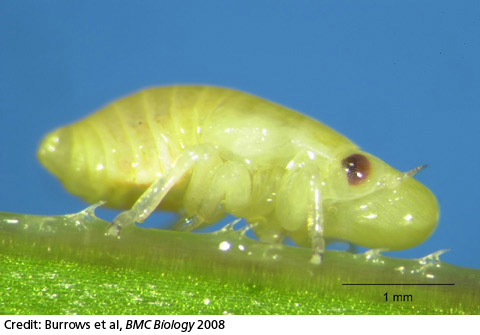Explain the amazing jump of the cicada dance
Large speed insects called jumping cicadas can jump about a hundred times longer than its body length. Now scientists have discovered the secret of cicadas: they possess bow-like structures but act like launchers.

Aphrophora alni reaches a body length of about half an inch (9 mm) and can jump to a height of 28 inches (700 mm).(Photo: Burrows et al, BMC Biology 2008)
The leap is also known as the spittlebug bug because in the pupae stage they create a foamy plastic to protect the pupa. Adult adults store energy in a pair of coupled tree structures made up of both hard epidermis and rubber-like proteins called resilin. These two structures are attached to the horseshoe of the jumping cicada.
When it has muscles to jump, the aforementioned structures bend like a bow. When turned on again, that 'bow' will push the cicada to jump upwards with a force that can reach 400 times its body weight.

As a child, cicadas do not have elastic proteins to be able to dance.So they only dance when they are grown up.(Photo: Burrows et al, BMC Biology 2008)
Because the arch structure of the jumping beetle is made up of flexible materials and hard materials, it can withstand damage even if it has to bend for a long time. In fact, you can always keep their bow in a ready position so you can prepare to jump in a split second. According to the researchers, they can also jump multiple times without harming the body.
While in the pupae stage, cicadas lacking in elastic proteins in their archetypal structure. As expected, the offspring cannot dance until they mature. The findings are published in BMC Biology.
- Cicada's love song entered the US Navy's sights
- Watching 'flying elephants' is extremely poisonous in Vietnam
- Secrets of jumping champion in nature
- Implant human eyes on cicada wings
- 'Olympic gold medal' for plants and animals
- The process of pupating molting into cicadas
- Robot dance to music
- Cicada 3301 - The most mysterious organization on the Internet
- He has a dance signaling death
- Men dancing also revealed gender capabilities
- Close-up of the cicada process
- The sexy tap-dance of the blue bird
 'Fine laughs' - Scary and painful torture in ancient times
'Fine laughs' - Scary and painful torture in ancient times The sequence of numbers 142857 of the Egyptian pyramids is known as the strangest number in the world - Why?
The sequence of numbers 142857 of the Egyptian pyramids is known as the strangest number in the world - Why? History of the iron
History of the iron What is alum?
What is alum?